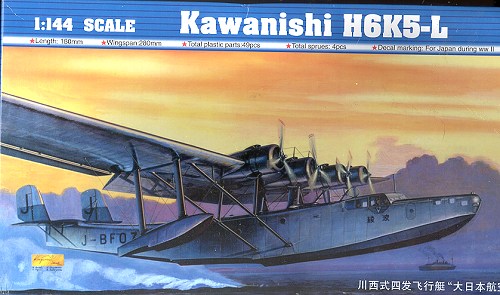
| KIT: | Trumpeter 1/144 H6K5-L 'Mavis' |
| KIT #: | 01323 |
| PRICE: | $16.95 MSRP |
| DECALS: | Two options |
| REVIEWER: | Scott Van Aken |
| NOTES: |

| HISTORY |
In 1933 the Japanese Navy issued a specification for a long range maritime reconnaissance flying boat. All of the entries did not satisfy the requirements so the manufacturers were sent back to the drawing board. The next year, the requirements were increased to require four engines, monoplane design, a range of 2,500 miles and a cruising speed of 120 knots. This was superior to all other flying boats in service at the time. Thanks to information gained by a visit to Short Brothers, a high winged parasol design powered by four 840 hp Nakajimia Hikari radials first flew in mid-1936.
Tests showed that some modification was needed to the hull to improve water handling. After manufacturers trials, the aircraft was handed to the Navy for service evaluations. The aircraft was found to be just what was needed, though a bit underpowered. The aircraft was the first in Japan to have a power operated turret, this being in the dorsal position. later prototypes were re-engines with 1,000 hp Mitsubishi Kinsei 43 radials and the aircraft entered service with the Japanese navy in January 1938 as the Type 97 flying boat model 11.
Since the all of Japan's long range airline routes were basically flown by flying boats, it was natural that the Type 97 would be considered and in 1940, the company produced a small series of H6K2-L Transport Flying Boats for use by Dai Nippon Koku K.K. All armament was removed and a cabin for 8 or sleeping accommodations for 4 followed by a seating compartment for 10 was designed. There was also space for a galley and mail storage as well as a head. A total of 38 H6K2-L and H6K4-L aircraft were built, including two converted from H6K4 patrol bombers. These aircraft flew routes throughout the war and were assigned the Allied code name 'Tilly'.
| THE KIT |
I'm going to direct you to Keith Walker's preview of the military version as there are only two differences between this kit and the military one. If you look at the sprues, you'll see a large open space. This is for four engine cowlings that have short carb intakes as shown on the box art). The other difference is a rear greenhouse with no gun slots and the portholes for the fuselage. Other than that, there is absolutely no difference at all in either the plastic or the decal sheet. Unfortunately, whomever was packaging my kit put in the sprues with the long carb intakes, despite photos of the aircraft having the shorter ones. You'll also probably realize from the write up that there was no H6K5-L, but that really doesn't matter as it is close enough. The transport versions also did not always have the prop spinners, but the kit props come with them molded in place so you are stuck with them unless you can rob them from some other kit.
Instructions are well drawn and leave no doubt as to where things go. They have color info where needed, though there is little of that as the kit comes without a cabin. This isn't a problem as the thickness of the small fuselage transparencies prevents any detail from being seen. As mentioned, the decals are identical to the other kit. They are well printed and will probably work OK with the use of setting solution. Markings are for two identical aircraft with only the last letter different in the registration. Both are overall aluminum or natural metal.
| CONCLUSIONS |
Regardless of how you look at it, this is a kit of a pre-post-war airliner, something of a very rare breed. Not only that, but it is in the standard airliner scale of 1/144, so will look great in your collection of 757s, Airbus 320s and Constellations.
Thanks to the fine folks at Steven's International, the importer for Trumpeter kits.
If you would like your product reviewed fairly and quickly by a site that has nearly 300,000 visitors a month, please contact me or see other details in the Note to Contributors.